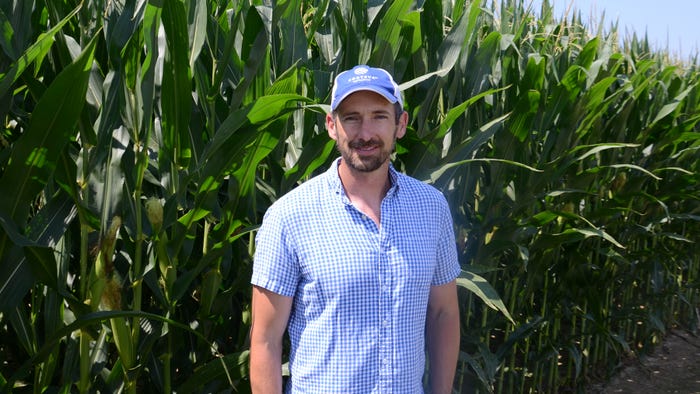
SEED ORIENTATION: Mark Jeschke, agronomy manager for Pioneer, traveled to Montgomery, Ind., last summer to see this plot featuring corn planted at different seed orientations.Tom J. Bechman
Michael Wagler saw articles indicating that how seed corn lay in the trench could affect plant growth. Always on the lookout for ideas that might interest his family’s Pioneer seed customers, he decided to put out a small demonstration plot to evaluate the idea.
“We weren’t sure what to expect, but as the season turned out, we saw interesting results,” Wagler says. He and his brothers Wes and Lynford, with their father, Dale, operate Rosedale Ag Service near Montgomery, Ind.
Mark Jeschke, agronomy manager for Pioneer, Johnston, Iowa, reviewed literature about the concept going back decades, and experimented with it himself over the years. Results were mixed.
The concept revolves around how the kernel is placed in the seed trench: tip up or tip down, and whether the germ where the coleoptile emerges faces perpendicular to the row or parallel to the row. The theory holds that if the tip is down, the radicle, or first root, starts more quickly, and the coleoptile, or first stem, also emerges faster. Plus, if the germ is parallel with the row, early leaves run with the row. But if the germ is perpendicular to the row, leaves orient themselves across rows, forming a more efficient canopy.
Historically, and still today, there is no equipment marketed to place every seed tip down, germ perpendicular. So, planting to test the concept is labor intensive.
“We tied up closing wheels and created seed furrows 1.5 inches deep, then planted by hand,” Wagler explains. “Our children helped.”
Their demonstration plot consisted of four approaches: tip down, germ across the row; tip down, germ with the row; tip up, germ with the row; and seed flat in the furrow.
Past and present results
In the past, some studies showed a yield advantage for uniform seed orientation, while others showed better uniformity of emergence and increased light capture but no yield effect, Jeschke says. A three-year study by Pioneer in the early 2000s showed different results each year.
The 2022 study at Montgomery produced some striking effects during the growing season, Jeschke says. First, seeds planted tip down emerged faster that those planted tip up — an average of 20 growing degree units faster.
“It was clear-cut and obvious,” Wagler says. “Then as leaves emerged, rows planted tip down with the germ parallel to the row emerged down the row, and leaves on rows where the germ was perpendicular, tip down, grew across the row.”
Jeschke adds that for rows planted tip up, leaves went various directions. That’s because the coleoptile must work around the kernel.
Light factor
Wagler watched expectantly to compare canopy closure. Rows where seeds were planted tip down, germ perpendicular to the row closed canopy quicker than rows planted tip down, germ parallel to the row.
Did quicker canopy closure result in more light interception? “Yes, it did,” Wagler says. “We measured it with a light meter from July 3 through July 13. Rows where the canopy closed first intercepted 40% more light.”
All of June and early July were hot and dry. Greater light interception in rows where leaves oriented across the row reduced daytime soil surface temperature around 14 degrees F. It was a noticeable difference, Wagler says.
To maintain demonstration plots for field days, they irrigated with drip tape beginning in early July. That interfered with capturing valid yield comparisons.
“Still, we were impressed, especially by the difference in plants when it was so hot and dry,” Wagler concludes.
Pioneer’s 2023 Agronomy Research Summary includes an article describing the seed orientation study. Jeschke and Dan Emmert, a Pioneer agronomist based in southern Indiana, co-authored the article titled “Effects of Seed Orientation at Planting on Corn Growth.” You can also contact Wagler on Twitter @RosedaleAg.
Seed orientation matters … so what?
One farmer commented to another at a field day featuring the seed orientation demonstration: “I don’t need to hear that since I can’t do anything about it.”
Indeed, Jeschke believes lack of available planting technology that can plant seed tip up or tip down, with the germ parallel or perpendicular to rows, likely helped curtail interest in testing seed orientation over the years.
“However, with the advent of planting technologies such as John Deere’s ExactEmerge, which maintain control of the seed from the meter until it is deposited in the furrow, manipulating seed orientation seems like much less of a leap in technology than it would have been 50 years ago, when research into the question was first conducted,” Jeschke says.
About the Author(s)
You May Also Like




